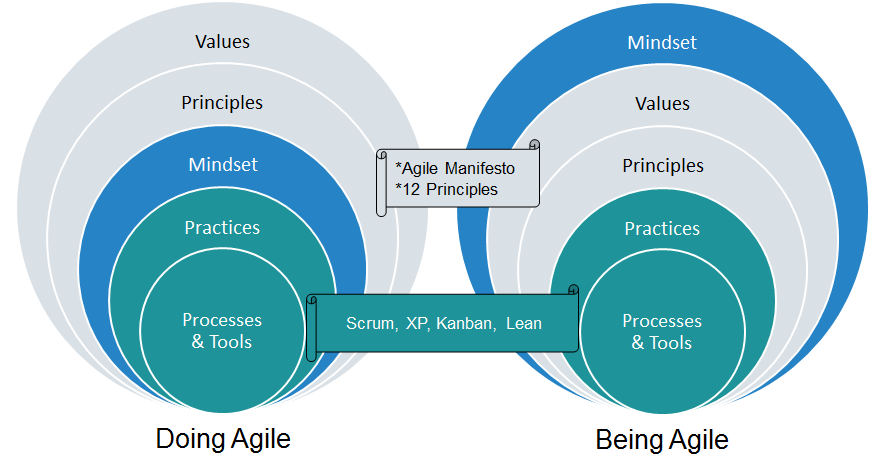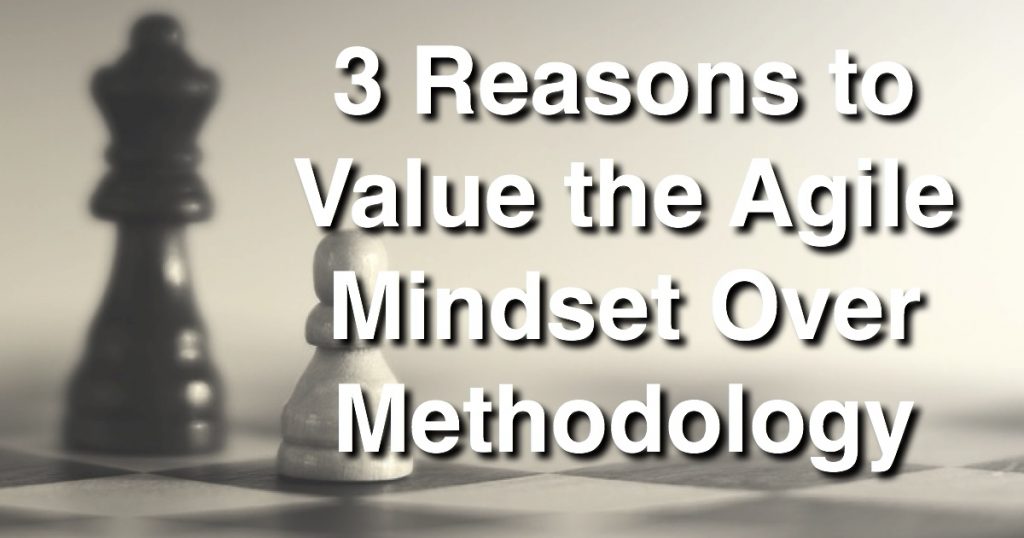You are focused on executing your Agile methodology well, but the question is, are you more focused on doing Agile or being Agile? Is there even a difference or is this some semantical nuance wrapped in a cliché?
You have probably heard statements like, “Agile is not something you do, it is something you are,” or “do not focus on doing Agile, but rather on being Agile.” Cute phrases, but what does this mean, if anything?
I assume you believe in the Agile values and principles enough to pursue Agile, or you at least desire the promised benefits. You have likely taken classes, gone to conferences, and attained certifications. But do you have the proper balance between developing your Agile mindset versus learning and doing specific methodologies and frameworks? There is a difference and it does matter. Let me explain.
Mindset Over Methodology
What do I mean by mindset over methodology? This concept can be polarizing because there are many people heavily invested in learning, doing, and teaching specific methodologies – the practices, the doing part. So, a statement like, “we value the Agile mindset over methodology”, runs the same risk that has plagued the Agile Manifesto for years. Invariably, someone will mistakenly assume that I am saying that we do not need any structured methodology, framework, or model.

The Agile Manifesto is a set of four core values that serve as the foundation from which all else derives. I want to point out that these value statements are written such that one thing is preferred over another. Again, it is not instead of, but rather, over. Think of it like, we prefer air over water. Both are necessary for life, but air is more vital, requires more frequent attention to ensure success.
“That is, while there is value in the items on the right,
we value the items on the left more.” – agilemanifesto.org
3 Reasons to Value the Agile Mindset Over Methodology
- Best Practices Are a Moving Target
- What You Do Reflects What You Value
- Agile Extends Beyond Software Development
Before we jump into the three reasons to value the Agile mindset over methodology, let me make it clear that I am not suggesting Agile methodologies are not important to learn and implement. You cannot become Agile without doing Agile-minded practices. Most methodologies and frameworks around Agile have positive aspects to them and you should absolutely learn several. Some of the more popular ones today include Scrum, Kanban, Lean Startup, Scaled Agile Framework (SAFe), and Disciplined Agile Delivery (DAD). By all means, study them and use what works.
The key is balancing mindset development with practical development. Here’s why…
Best Practices Are a Moving Target
What is a “best practice”? A best practice is a way of doing something that industry has determined, through trial and error, to be the most commonly accepted and effective way to do a thing. For example, how to conduct retrospectives, how to plan and schedule, or how to deliver more frequently.
The Elusive Promises of Agile
You are on a seemingly endless quest to seek out, learn, and employ the latest and greatest Agile processes, techniques, and tools to help you better achieve your missions. In this pursuit, you are spending a lot of time and money each year chasing the latest trends in methodology, the latest professional certifications, and the latest best practices that will supposedly end all your woes.
You then endure the slow process of trying to infiltrate your teams with this new way of working. It seems like as soon as some traction is gained in the Agile transformation, something new comes along to derail what little progress you made. That well-oiled machine you envisioned remains out of reach as the next paradigm, or methodology, is pursued and you are told to rethink everything…yet again. Can you relate?
It is not that pursuing these trainings and certifications is a waste of time. Quite the contrary. The point is, these things come and go. Best practices are a moving target. For example, if you are a seasoned professional, chances are you have attained some professional certifications in your career that today are less relevant, if not obsolete. I venture to presume that you have also taken classes and received training on methodologies, practices, and tools that you no longer use. Am I right?
The problem is not in learning and implementing methodologies and best practices. The problem is not aligning what you do with why you do it. When the why is not established, when things change, you are not building back on top of a solid foundation of values, you are essentially starting over. This makes change even harder to accommodate.
What you do matters; why you do it matters more. Share on XWhat You Do Reflects What You Value
Simple observation of your team in action will reveal what it values and which principles drive the team’s work. Think about it, what you do, or perhaps more fittingly what your organization does, is a direct reflection of what it collectively values and believes about how work should be done. It may not be tied together consciously, but the connection is there none-the-less.
At work, your processes, practices, and methods are all built from the foundation of the collective mindset of the organization as it relates to the work you do and how you go about doing it. Therefore, properly establishing the foundation of your values and principles is crucial to embodying the Agile mindset. What you do derives from that and is only as effective as your core beliefs allow.

The graphic above shows the difference between doing Agile and being Agile. Ultimately, it’s not so important what you do as a practice so long as it derives from and aligns with the core Agile values and principles. What is your mindset wrapped around? Are you more focused on what you do or why you do it?
Shu-Ha-Ri
Before you can ever “become” Agile, you must “do” Agile. But I believe far too much focus is on and stays within doing that becoming is never achieved. Have you heard of the Japanese stages of learning concept called ShuHaRi, or Shuhari, or Shu-Ha-Ri? Most teams get stuck in Shu and Ha and never break into Ri, which is why I think teams struggle with ultimate agile transformation success.
Shu is that stage where you are learning from a teacher and follow exactly what is taught and how to perform the tasks without much regard for theory or why. Even if there are multiple ways to perform a task, you will concentrate on the one way instructed.
Ha is that stage where you are now learning from other teachers and beginning to think about why and the theories behind the practices. You may mix and match some teachings from various teachers.
Shu-Ha is where most people stop, so when situations present that do not fit the learned prescriptions, they do not know what to do.
Timeless Agility is about going from Shu-Ha to Ri.
Ri is where you aren’t really learning from other people any more. You may borrow and edit practices you learned along the way, but you are also more likely creating your own ways of working based on your own experience and learned mindset. Shu-Ha is “doing” Agile and Ri is “being” Agile.
Agile Extends Beyond Software Development
The Agile methodologies we learn and do are primarily built around software development. The Agile Manifesto, after all, was certainly crafted with that focus. But Agile is not only beneficial for software development.
Agile for marketing and Agile for change management are movements gaining traction. If you really think about it, Agile values and principles apply to any organization and any industry.
The empirical process of do, experience, learn, and adjust is a timeless way to build quality products and services. Working closely with others in tight feedback loops is a way of working that benefits any team. Delivering early and often and having flexibility to always do the next right thing are ideas hardly anyone would reject.
When you focus more on establishing your Agile mindset, you’ll begin to see more ways to apply Agile thinking throughout your organization, or even across industries, and you will be adept at knowing how to apply the mindset to each team’s unique situation and process. Again, you will be working from Ri rather than Shu or Ha.
Summary
Just like in the Agile Manifesto where both the left and right part of each value statement is important and yet the left side is more important, the same holds true for Mindset Over Methodology. Yes, you need to learn and do Agile practices, but you need to understand why you are doing what you are doing first and foremost. And many times that why is not aligned with what Agile intends.
Do not be constrained by your methodology. Focus equally, if not more so, on your mindset development as your methodologies.
Seek Timeless Agility because Mindset Transcends Methodology. To learn more about the Timeless Agility mindset and approach, get the book, Pursuing Timeless Agility: the Path to Lasting Agile Transformation.
